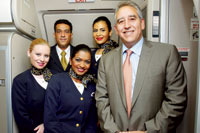
GULF Air, Bahrain’s national carrier, is on course to achieve break even in 2012 as its new strategy bears fruit.
The revenues are increasing, losses are coming down and there is considerable confidence among all stakeholders that the airline is moving in the right direction, says the airline’s CEO, Samer Majali (pictured with crew).
He spoke to TTN on board the inaugural Colombo flight, the latest addition to the carrier’s network.
What is the strategy behind the new route launches as they are primarily targeted at secondary cities?
Most of the large carriers are more concerned with the primary routes, so there is an opportunity to serve the secondary destinations, which are much more viable in spite of having smaller populations. Gulf Air is in a leading position to benefit from this situation.
The strategy involves maintaining our position as the airline with the region’s most extensive network.
Is the network expansion more region-focused or international?
The expansion is going to be primarily in the region. We are not only starting new destinations, but also increasing flights to the existing locations. The regional destinations also offer opportunity for longer range as they are connected to other destinations through Bahrain. Our aim is to provide a seamless connection to our passengers through Bahrain.
Is Gulf Air moving away from traditional destinations such as Europe and India?
Not at all. We evaluate the destinations and, if they are viable, make good economic sense, then we fly. We remain very much present in India and Europe but we rationalise capacity according to the demand.
There has been a talk of Gulf Air being targeted by BA for buy-out. Are there any discussions under way?
They have denied it. The report said that we are in talks, but we are not in talks with them. However, Gulf Air remains interested to cooperate either as an alliance partner or even deeper co-operation with any other carrier if that would make commercial sense.
What is the progress on plans to join an airline alliance?
We are looking for an alliance that is interested in Gulf Air joining it and which can provide value for Gulf Air in return. We believe that we have a strong network in the region and are best placed to be attractive to an alliance.
How is the new strategy working towards bringing Gulf Air back to black?
The new strategy will result in increasing our revenues and in reducing costs. When that happens our losses will come down and we will approach break even.
We are moving in the right direction, revenues have increased, costs have reduced, losses are getting smaller and smaller. This is exactly what is happening this year. Obviously a dramatic change requires time. It takes time to open new routes, to introduce new planes, to reduce overheads and to come out of the long-term contracts that we have had. The plan is making progress.
What is the goal for 2011?
The same… increasing the network itself, freezing non-viable destinations and adding new planes. The introduction of new planes will set the pace of network changes. With the induction of 12 new aircraft in the past 12 months and the phasing out of 12 older aircraft, the average age of our fleet is just 6.8 years – which compares very well with the region’s other airlines. This means we are offering our customers a modern, fuel-efficient and younger aircraft to fly to their destination of choice as we continue to re-fleet.
How is the support for the new strategy from the Gulf Air family?
We are getting a lot of support from the leadership and the government. The management is very supportive and has embraced changes. The union is also well-engaged with us. All of us are working for the benefit of the company, its future.
Any turnaround requires commitment from all parties. From what we have seen there is confidence among people – both internally and externally – that the plan will succeed. There is incentive for all to move in the right direction. The confidence emanates from the success achieved so far.
What are your expectations for the Colombo route? Are there plans for daily flights?
With the war ending, there is a far bigger potential for Sri Lanka to develop as a destination. The new route will encourage tourism from Bahrain, Saudi Arabia and other points in the region to Sri Lanka and also help the movement of businessmen and workers to Bahrain and the region from that country.
As the demand improves and the seat factor increases beyond a certain level, we then can provide seat capacity. It all depends on how much the customer likes the service.
You have talked about flying double-daily to all Gulf capitals. When will this be implemented?
We are hopeful of this happening in 2012. Our aim is to serve every capital and major city in the region with at least a double-daily service; this objective can now be achieved thanks to the size, reliability, comfort and unbeatable economics of our new regional jets. However, in many countries, permission for additional flights is an issue and all depends on the authorities there.
